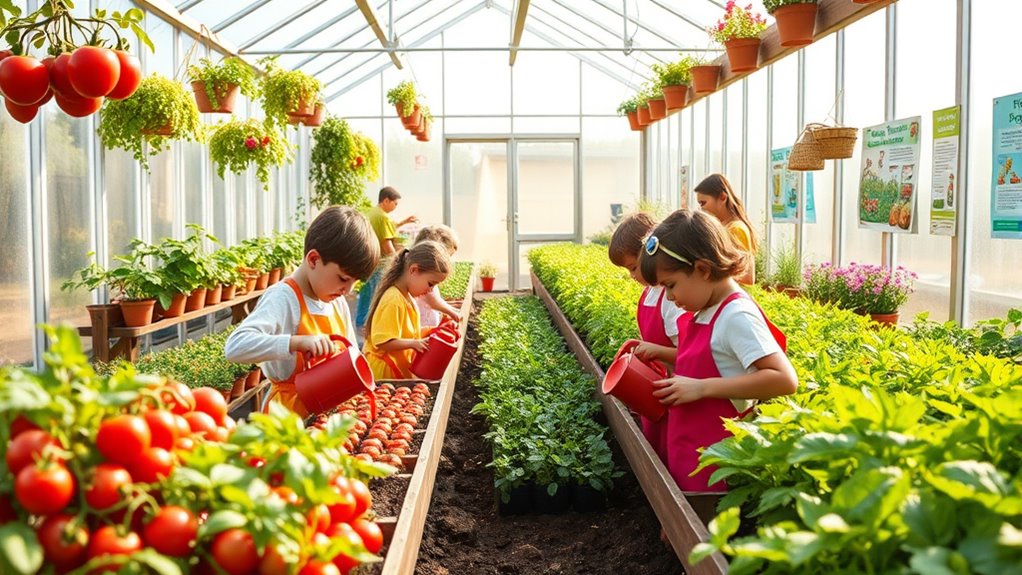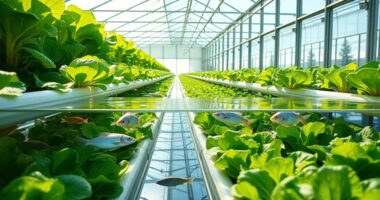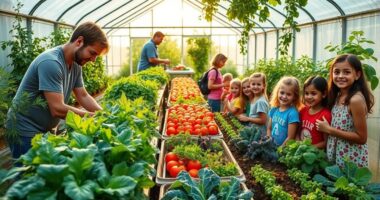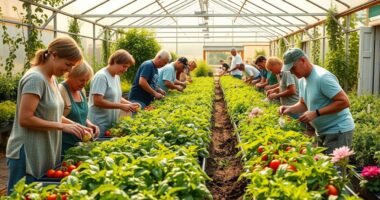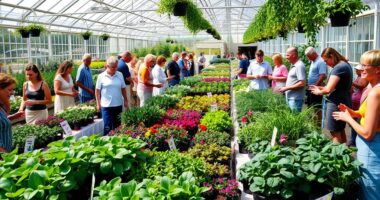Educational greenhouses give you the chance to engage students in hands-on learning about sustainability, science, and teamwork. By designing, maintaining, and monitoring these spaces, you help students develop essential skills while exploring ecological principles and agriculture. Incorporating projects like plant propagation or environmental monitoring makes lessons more interactive and meaningful. If you’re interested, you’ll find more ideas on how greenhouses can transform learning and inspire responsible environmental stewardship.
Key Takeaways
- Greenhouses provide hands-on learning environments that teach students about plant science, ecology, and sustainable practices.
- They foster experiential activities like propagation, environmental monitoring, and crop growth projects to develop scientific skills.
- Incorporating climate control and pest management teaches students about sustainable greenhouse operations.
- Greenhouse projects promote teamwork, responsibility, and problem-solving through real-world gardening tasks.
- Integrating greenhouses into curricula enhances environmental awareness and community engagement beyond traditional classroom learning.
Benefits of Incorporating Greenhouses Into School Environments
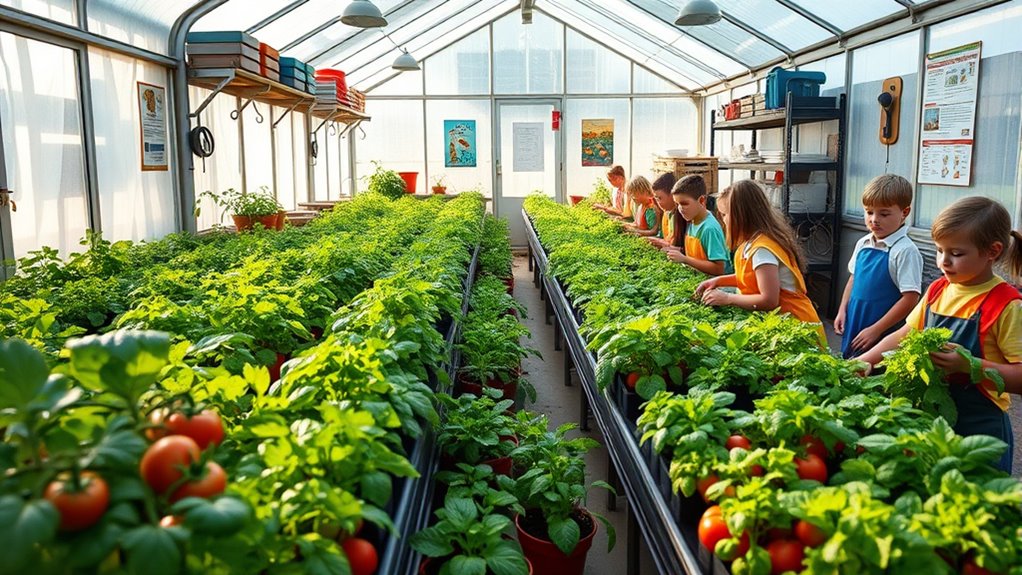
Incorporating greenhouses into school environments offers numerous educational and practical benefits. You’ll foster sustainable practices by teaching students how to grow food responsibly and reduce environmental impact. Greenhouses serve as hands-on learning spaces where students develop eco-friendly habits and understand the importance of conservation. Additionally, they enhance community engagement by involving parents, local organizations, and residents in gardening projects and events. This collaborative approach not only supports environmental education but also cultivates a sense of community involvement and shared responsibility for environmental stewardship. The greenhouse becomes a focal point for collaboration, encouraging teamwork and leadership among students. Promoting environmental stewardship through ongoing greenhouse activities can inspire students to adopt eco-conscious behaviors beyond the classroom. Sustainable practices can be reinforced through ongoing greenhouse activities that promote environmental awareness and responsibility. Furthermore, integrating greenhouse projects into the curriculum can improve students’ understanding of scientific concepts through experiential learning.
Designing and Setting Up an Educational Greenhouse
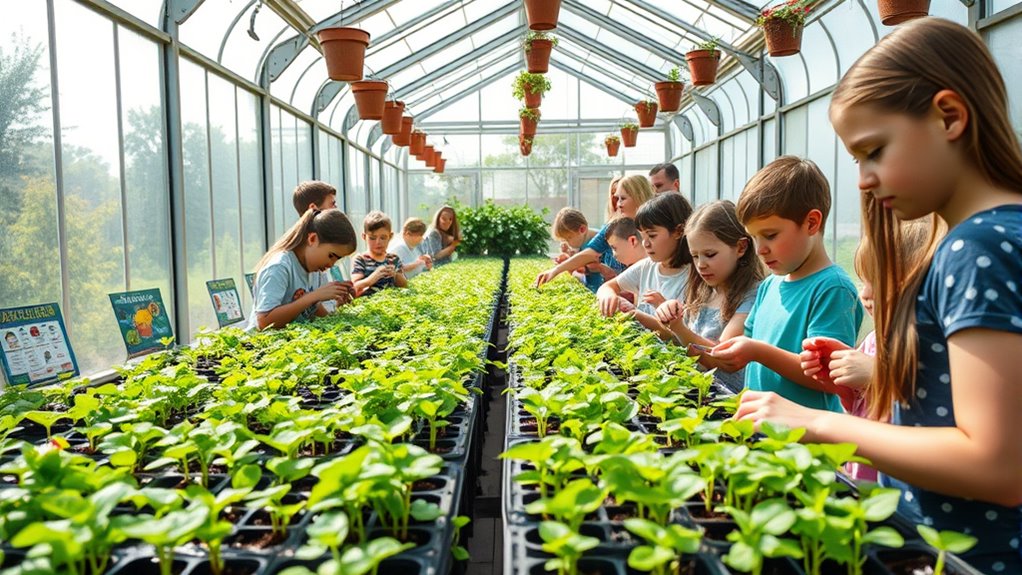
Designing and setting up an educational greenhouse requires careful planning to guarantee it meets both educational goals and practical needs. You need to take into account climate control to maintain ideal temperatures and humidity, ensuring plants thrive and learning is effective. Pest management is equally important; establishing barriers or integrated pest control methods helps protect plants without harmful chemicals. When planning, think about the layout, access points, and tools needed for hands-on learning. Use this simple table to guide your setup:
| Aspect | Consideration |
|---|---|
| Climate Control | Ventilation, heating, shading options |
| Pest Management | Barriers, natural predators, sanitation |
| Layout & Access | Pathways, raised beds, storage areas |
Proper design ensures a functional, engaging space for students to explore and learn through growing. Incorporating sustainable practices into your greenhouse design can also promote environmental awareness among students, aligning with educational goals. Additionally, considering climate control options like shading and heating can help maintain optimal conditions for diverse plant types. Understanding ethical hacking principles like risk assessment and vulnerability management can also inspire innovative security measures for greenhouse technology systems.
It is also beneficial to include features that facilitate interactive learning, such as observation stations or digital monitoring tools, to enhance educational engagement.
Curriculum Integration: Making the Most of Greenhouse Learning Opportunities
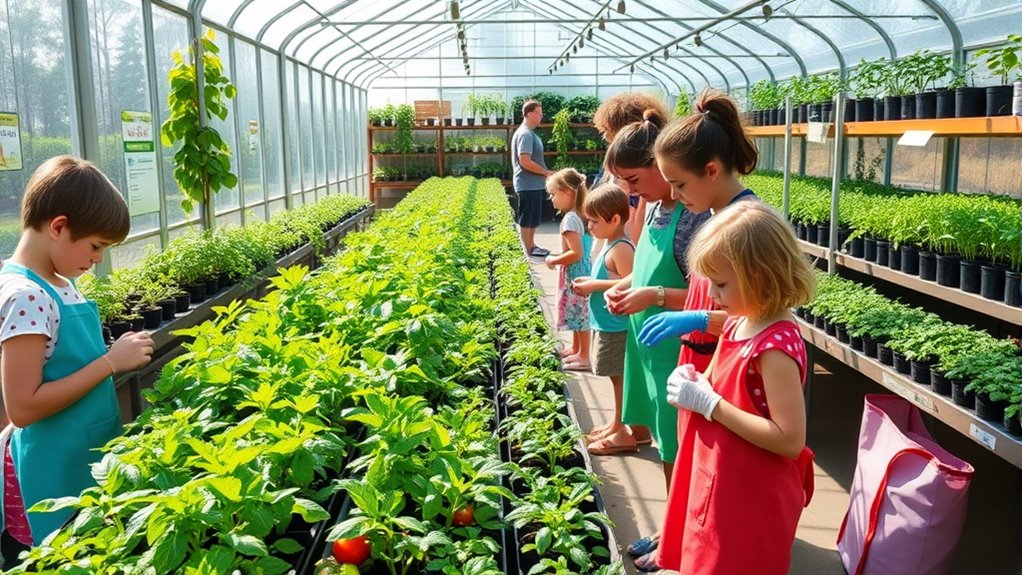
How can you maximize the educational value of your greenhouse? Start by aligning activities with your curriculum goals, integrating plant science and gardening techniques into lessons. Use hands-on experiences to deepen understanding, encouraging students to observe growth patterns and experiment with variables. Incorporate these strategies: 1. Design lessons that connect greenhouse activities to core science standards, emphasizing plant biology and ecology. 2. Use gardening techniques to teach responsibility, teamwork, and problem-solving through daily plant care. 3. Incorporate data collection and analysis to develop students’ scientific inquiry skills, linking theory to real-world applications. Additionally, leveraging vetted indoor gardening products can enhance student engagement and practical learning experiences. Creating opportunities for students to explore self watering plant pots and other innovative gardening tools can further deepen their comprehension of plant care systems. Exploring regional agricultural practices can also provide context for environmental and economic impacts, enriching students’ understanding of sustainable farming methods.
Student Projects and Experiential Activities in Greenhouse Settings
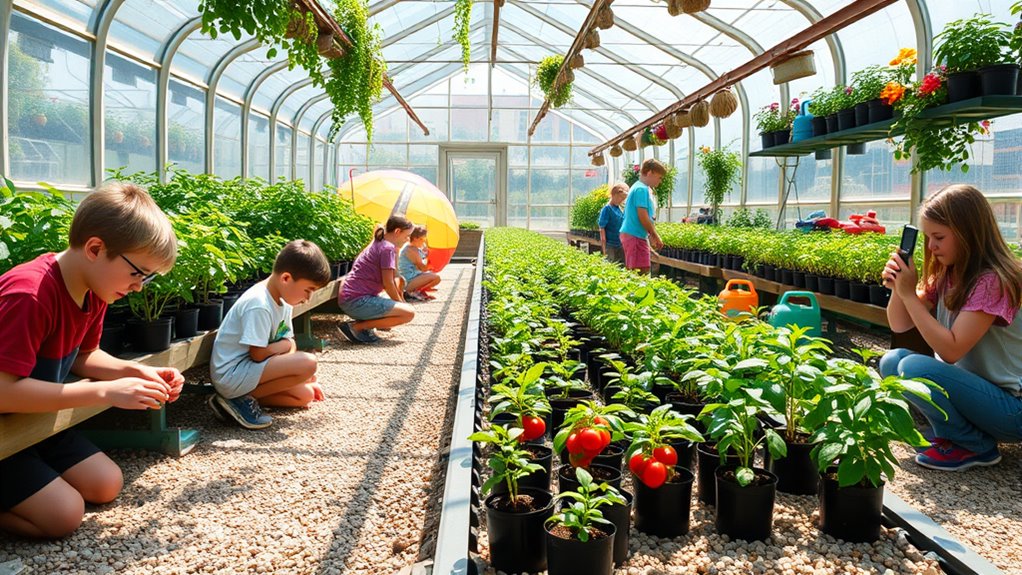
Student projects and experiential activities transform the greenhouse from a simple growing space into a dynamic learning environment. You might guide students through plant propagation, where they learn to clone plants and understand growth processes firsthand. Environmental monitoring becomes a hands-on activity, teaching students to measure temperature, humidity, and light levels, fostering an understanding of ideal conditions. These projects encourage problem-solving, teamwork, and scientific inquiry. To visualize, consider this table:
| Student Activity | Learning Focus |
|---|---|
| Propagation experiments | Cloning plants, understanding growth |
| Monitoring environmental data | Analyzing conditions for healthy growth |
| Growing seasonal crops | Practical farming skills |
| Designing mini-greenhouses | Engineering and design principles |
| Recording growth progress | Data collection and analysis |
These activities make learning tangible and engaging, connecting theory with real-world application. Additionally, incorporating energic alignment principles can enhance student engagement and foster a positive learning environment. For example, integrating innovative greenhouse technologies can provide students with insights into modern sustainable farming practices. Furthermore, emphasizing the importance of AI security can help safeguard sensitive project data and ensure a safe learning experience. Understanding self-sustaining systems can also enrich students’ comprehension of eco-friendly greenhouse management, which aligns with best practices for maximizing efficiency in greenhouse operations.
Challenges and Solutions for Maintaining School Greenhouses
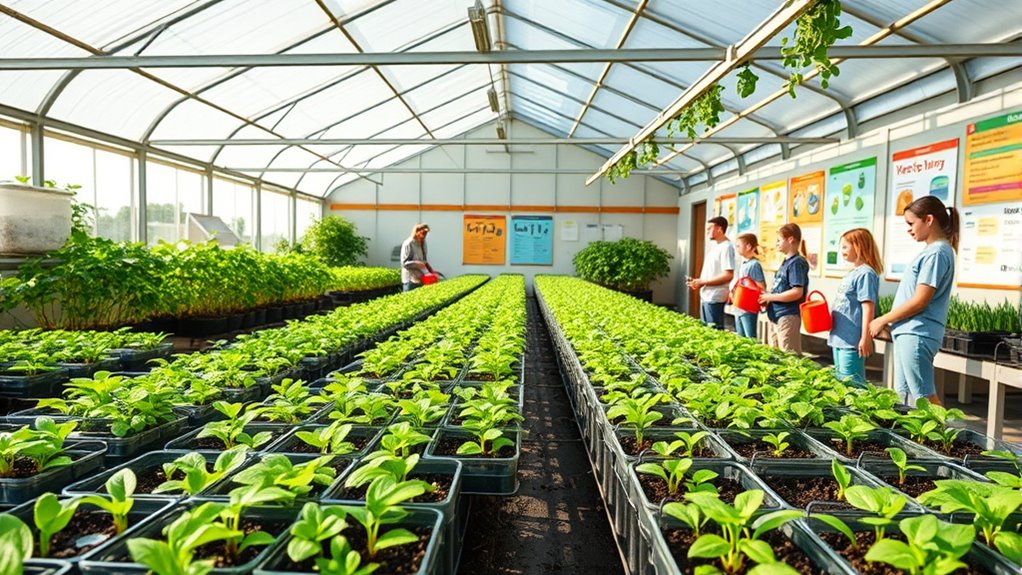
Maintaining a school greenhouse presents a variety of challenges that require careful planning and consistent effort. Climate control is essential; you must monitor temperature and humidity to prevent stress on plants. Digital literacy programs can also be beneficial in training students and staff to utilize technology effectively for climate monitoring and pest management. To ensure effective pest management, consider integrating biological controls and manual removal strategies. Pests can quickly damage crops if not addressed promptly. To tackle these issues, consider these solutions:
Keeping a school greenhouse healthy requires careful planning and consistent climate monitoring.
- Install reliable ventilation and shading systems to regulate climate efficiently.
- Use integrated pest management strategies, combining biological controls and manual removal.
- Schedule regular inspections to catch problems early and adjust environmental settings as needed.
Frequently Asked Questions
How Cost-Effective Are Educational Greenhouses for Schools?
When you consider how cost-effective educational greenhouses are for schools, you need to do a thorough cost analysis and budget planning.
While initial setup costs can be significant, they often lead to long-term savings through sustainable practices and hands-on learning.
You’ll find that investing in greenhouses can boost student engagement and environmental awareness, making them a valuable educational tool that balances costs with educational benefits.
What Safety Precautions Are Necessary for Student Greenhouse Activities?
Ever imagined students working safely while tending plants? You need to implement clear safety protocols and hazard prevention measures, like wearing gloves and eye protection, to keep everyone safe.
Supervise activities closely and establish rules for handling tools and chemicals. Do you see how these precautions create a secure environment?
How Can Greenhouses Be Adapted for Different Climate Zones?
You can adapt greenhouses for different climate zones by focusing on climate adaptation and customizing greenhouse design.
In colder areas, add insulation, heating systems, and thermal mass to retain heat.
For warmer regions, incorporate shading, ventilation, and evaporative cooling to prevent overheating.
What Grants or Funding Options Are Available for School Greenhouses?
You should explore various grant opportunities and funding sources available for school greenhouses. Many local, state, and federal programs support educational projects, including greenhouses, to promote STEM and sustainability.
Look into grants from organizations like the USDA, environmental nonprofits, and education departments. Applying for these grants can provide essential funds for purchasing materials, setting up the greenhouse, and ongoing maintenance.
This funding can help you create a valuable learning environment.
How Do Greenhouses Impact Student Mental Health and Well-Being?
You might notice that greenhouses boost student mental health benefits and emotional resilience.
As students nurture plants, they experience reduced stress and increased focus, creating a calming environment that fosters well-being. The act of caring for living things builds confidence and patience, helping students develop resilience.
These green spaces connect students with nature, encouraging mindfulness and emotional balance, ultimately supporting healthier, more resilient learners.
Conclusion
Think of your school greenhouse as a tiny forest, where each student becomes a gardener of knowledge. As you nurture plants and watch them grow, you’re also cultivating curiosity, responsibility, and teamwork. Just like tending to a garden, maintaining the greenhouse requires care and patience, but the rewards—bright minds and thriving students—are worth it. Embrace this green sanctuary, and watch your educational journey blossom into a vibrant, lifelong adventure.
